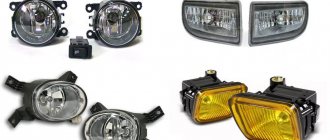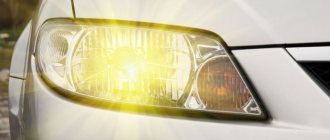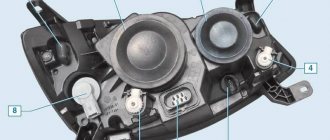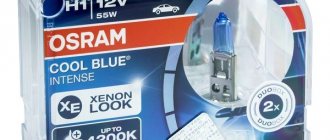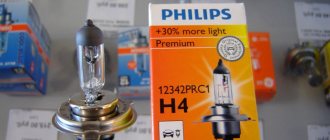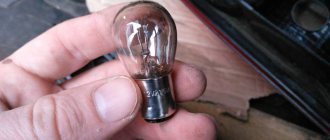Nothing characterizes the modern man more than his car. And it’s not so much about the prestigious or luxury brand of car, and not even about the amount of money earned through back-breaking labor, given for your iron friend, but about the care for the appearance of the car, on the maintenance of which some spend not only their whole weekend, but also all their blood
Fortunately, the market for car accessories is quite rich, and even the most demanding motorist will be able to find a “lotion” that is suitable for him. And if the theater, according to a popular expression, begins with a hanger, then auto tuning begins with alloy wheels and xenon headlights.
Xenon headlights
Xenon is an inert gas with serial number 54 in the periodic table. Its content in the earth's atmosphere is extremely negligible and today the only industrial way of obtaining it is to separate atmospheric air into its main components: oxygen and nitrogen and produce liquid oxygen. A by-product of both processes is xenon. These factors - rarity and difficulty in obtaining - are responsible for its exceptional high cost compared to other noble gases.
Gas-discharge xenon lamps were first used as low-beam headlights by BMW in 1992, and since then the victorious march of this automotive lighting technology throughout the world has been unstoppable.
Strictly speaking, it would not be entirely correct to call these lamps xenon. In fact, they are metal halide : the arc is ignited in a xenon atmosphere and heats sodium and scandium salts. Already their vapors, together with mercury vapors, give the emitted light a characteristic dazzlingly bright blue color.
Xenon lamps have a number of advantages over halogen lamps:
- Their appearance is most favorable for the motorist's eyes , since its spectrum is close to daylight. Thanks to this fact, the car driver’s eyes are not so strained and get tired less often, which means that the severity of his reaction remains at a high level much longer, which is especially important on the road at night. According to statistics, driver fatigue is one of the most common causes of road accidents at night. In this regard, xenon lamps really increase the level of safety on the roads.
- An additional advantage is their durability compared to halogen lamps. The service life of certain types of xenon lamps can be up to 3000 hours versus 400 hours for most types of halogen lamps. This is explained primarily by the absence of a tungsten filament in the gas-discharge bulb, which is the most vulnerable part of classic incandescent lamps.
- The light of xenon headlights does not scatter in rainy weather , which was not uncommon among owners of cars with conventional headlights. This way, a “wall of light” is not created, which reduces the risk of accidents.
- Xenon lamps consume much less electricity than conventional lamps.
However, in addition to the obvious advantages, this type of lamp also has several negative qualities. The first of these includes the possibility of blinding the driver of an oncoming car . During normal operation, the headlights are directed downwards onto the road. However, if the installation of the headlights was done incorrectly, or if they were adjusted by an outright hack, then unpleasant moments on the road cannot be avoided. It is for such cases that a dynamic light beam corrector is needed.
Xenon, as already described above, is an expensive gas , both due to its low prevalence in nature and the difficulty of obtaining it. As a result, devices based on it are expensive, although a significant portion of the price is also added by the complexity of the lamp itself as a product, as well as its installation and adjustment.
Additional equipment is required to ensure proper and safe operation of the lamps.
Replacing a lamp that has become unusable should be done in pairs with a second one, since the new lamp will shine a little differently from the “old” one.
Xenon and bi-xenon - differences
What is the difference between xenon and bi-xenon? To answer this question, you need to understand how each type of car lamp works. In xenon lamps, switching between low/high beam occurs in three ways:
- Installing light sources at different angles.
- Changing the installation angle of one lamp.
- Using a special curtain that blocks the direction of the main beam.
Article on the topic: Punishment for not fastening a seat belt
In the first case, the headlight is equipped with two lamps that are installed at different angles. Thanks to this, turning on the low beam lamp illuminates the area next to the car. When the high beams are turned on, the light beam rises, illuminating a distant space. In the second case, switching between low/high beam occurs by changing the angle of the lamp relative to the reflector, which plays the role of a mirror. Changing the angle at which the light hits the reflector changes the direction of the light coming from the headlight. The lens does not change the general direction of the light beam, but gives it the necessary shape.
The first method allows you to simplify the control of the headlamp, but requires two sets consisting of an auto lamp and an ignition unit. The second method allows you to get by with one set, but its electromechanical drive is not highly reliable and requires proper care. The third method is the least efficient because low beam uses only half the lamp's energy.
Which method is better, everyone decides for themselves.
Unlike xenon, bi-xenon has a different mechanism for changing the direction of the light beam, which allows it to be better controlled. Depending on the location of the charge, the general direction of the headlamp beam changes. Therefore, in bi-xenon, the electromagnet moves the electrodes, due to which the location of the discharge changes. In this case, the discharge itself does not stop. This control method makes it possible to eliminate unreliable electromechanical drives and switch low/high beams by applying voltage to the electromagnet contacts. Another advantage of bi-xenon lamps is the ability to smoothly adjust the angle of the light beam. To do this, it is enough to change the voltage supplied to the electromagnet. Therefore, the only difference between xenon and bi-xenon is the method of changing the direction of the light flux.
Xenon and bi-xenon - installation features
Installing xenon involves connecting a horn unit. It's better to do this near the headlight. You will not have to make any other changes to the vehicle's electrical wiring. Installing bi-xenon will require serious modifications to the headlight control circuit. If you are not a professional auto electrician, then it is better to entrust this work to a specialist. After all, you will need to disconnect the low and high beam relays, and connect the control unit instead. In addition, you will have to find a place for the ignition unit, which, as in the case of xenon, must be located near the lamp.
Bi-xenon headlights
Initially, xenon was installed only on low beam headlights, so ignition of the electric arc took several seconds and therefore switching from low beam to high beam was quite slow and did not meet the needs of the automotive industry aimed at increasing safety.
However, over time, new lamps were created under the general name Bi - Xenon (bi-xenon), which were able to solve this problem. In such lamps, switching from low beam to high beam is carried out in several ways, depending on the manufacturer:
- By raising/lowering a special curtain, thereby cutting off part of the light purely mechanically. This is done using a special electromagnetic drive.
- The lamp moves in a horizontal plane, switching from one mode to another.
- One bulb combines two gas-discharge lamps: one for low beam, the other for high beam.
What is the difference between xenon and bi-xenon
The internal part of xenon lamps is filled with gas, does not have a traditional filament in its design, and the principle of operation is the passage of high voltage between a pair of electrodes, which causes the gas to glow. Xenon lamps have constant radiation and are not able to change its direction. Standard xenon, as a rule, provides only low beam; halogen headlights are installed for high beam.
The glow of xenon lamps is formed as a result of the formation of an electric arc
All bi-xenon lamps are essentially the same xenon light sources; the main difference is the presence of a mechanism that allows you to change the direction of the glow. This mechanism is a special metal curtain, controlled by a conventional magnet depending on the selected mode.
The prefix bi- in the word bi-xenon indicates that the lamp combines two functions - low and high beam.
Installing bi-xenon will require radical changes to the standard lighting system
Application
Xenon headlights are installed not only in expensive brands of cars, but also in budget options. In addition, it is now possible to install gas-discharge lamps on used cars.
If the headlight of such a car is separate, then four xenon lamps are installed for low and high beam, respectively. If the headlight has an undivided module for both modes, then bi-xenon is suitable here.
Of course, the cost of installation is quite expensive, not to mention the high cost of the lamps themselves. In addition, a prerequisite for their use is the installation of a dynamic light beam corrector and headlight washers.
Auto and motorcycleComment
Advantages of xenon and bi-xenon
High power of the light beam with minimal power consumption.- Bright white light promotes better orientation on roads at night and in poor visibility.
- Long service life, more than 2000 hours, which helps reduce the cost of maintaining the vehicle lighting system.
- All the advantages of xenon, together with two types of glow: near and far, make up bi-xenon.
What is bi-xenon
Do not think that a xenon lamp is a guarantee of eternal happiness and the absence of problems with light. Not at all. By installing a xenon lamp on a car, you get a replacement for only one spiral of a halogen lamp - low beam or high beam. A xenon lamp does not have any filaments, and therefore can only work as a low or high beam lamp. But in order to eliminate this annoying drawback, smart manufacturers began to offer bi-xenon lamps - xenon, but with high and low beam functions.
Bi-xenon is xenon with low and high beam function
Changing the direction of the glow is how xenon differs from bi-xenon. This possibility is realized thanks to the design of the base, which can change the angle of direction of the light flux. Under the influence of a magnet, the mechanism sets in motion a reflective curtain, which directs the light at the desired angle. Bi-xenon can be installed on those vehicles where the installation of two separate lamps for high and low beam is not provided. The cost of a bi-xenon lamp is even higher than the cost of xenon, since the price of the drive mechanism and control unit is added to the lamp. You can only save on installation by doing all the work yourself.
From an economic point of view, installing a bi-xenon kit is still more profitable than using halogen lamps, taking into account the service life of xenon. The only thing that stops the public from using such lamps is a substantial one-time financial investment.
Nevertheless, it definitely makes sense, since the quality indicators of xenon light are head and shoulders above those of halogen. The choice, as always, is yours, but traffic safety can hardly be expressed in monetary terms.
We will answer your questions for FREE regarding deprivation of rights, road accidents, insurance compensation, driving into the oncoming lane, etc. Daily from 9.00 to 21.00
Moscow and Moscow region
St. Petersburg and Leningrad region
Free call within Russia 8-800-350-23-69 ext.418
What is bi-xenon for?
Many car enthusiasts who are familiar with the operating principles of xenon and/or use it very often do not know what bi-xenon is, why it is needed and how it differs from xenon. For more details, see the article - how does xenon differ from bi-xenon. But the answer is very simple.
In cars, to produce low and high beams, as a rule, two lamps of different power are used - xenon or others. So, bi-xenon replaces two of them at once, since it has the ability in its design, even with inseparable optics, to change the direction of light, i.e. switch the latter - from far to near and vice versa.
Compare xenon and bi-xenon
In simple terms, the main difference between these lamps is that the xenon version can only produce low beam, while the bi-xenon version is universal in this regard - it can turn on both low and high beam. In bi-xenon, the focus (far and near) of conventional xenon changes, which is able to change its position using a curtain reflector or a floating bulb.
Xenon is often installed on luxury cars. Such headlights illuminate the roads wonderfully, and by replacing the usual halogen ones with xenon ones, you will be surprised at how you ever managed without them. And high-quality lighting is the key. The light from such lamps does not blind drivers driving in oncoming traffic; the lamps themselves are cheaper and last 2 years in the worst case.
The design principle of xenon and bi-xenon lamps is identical; they also do not differ in brightness level, efficiency and reliability. However, if your car does not have separate optics, then it is better to choose bi-xenon. You can install them without outside help if you follow the instructions.
